Film director, producer, and actor Friedrich Zelnik or Frederic Zelnik (1885-1950) was Austrian, but he directed two of the most popular Dutch films of the 1930s. He was initially an actor, who became one of the most important producers-directors of the German silent cinema. During the 1920s he had his greatest successes as director-producer of operetta style costume films starring his wife, Lya Mara. A critical success was his drama Die Weber/The Weaver (1927). After 1933, he worked in Great-Britain and in the Netherlands.
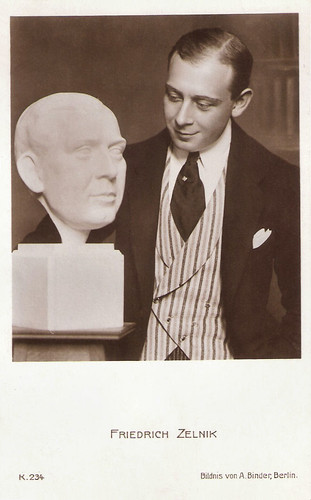
German postcard by Photochemie, no. K. 234. Photo: Alex Binder, Berlin.
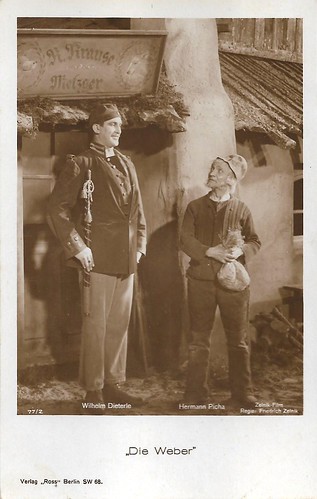
German postcard by Ross Verlag, Berlin, no. 77/2 Photo: Zelnik-Film. Wilhelm Dieterle and Hermann Picha in Die Weber/The Weavers (Friedrich Zelnik, 1927).
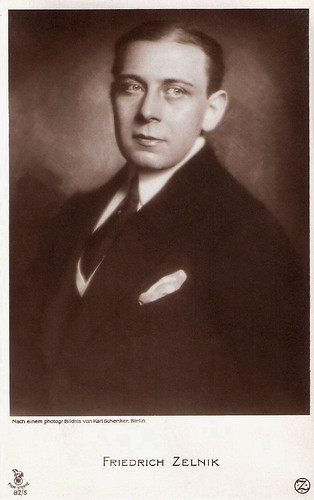
German postcard by Rotophot in the Film Sterne series, no. 82/5. Photo: Karl Schenker, Berlin.

German postcard by Rotophot in the Film Sterne series, no. 126/3. Photo: Nicola Perscheid, Berlin.

German postcard by Ross Verlag, no. 3413/1. Photo: Defina / Defu. Lya Mara in Heut tanzt Mariett/Marietta (Friedrich Zelnik, 1928).
Friedrich Zelnik was born in 1885 in a Jewish family in Czernowitz, then the capital of the Duchy of Bukovina in the Austrian part of the Austro-Hungarian Monarchy (today Chernivtsi, Ukraine). Czernowitz was largely populated by Jews. After Wilno it was the most important city for the Jewish culture in Eastern Europe.
Zelnik studied law in Vienna, but then worked as an actor in theatres in Nürnberg, Aachen, Worms, Prague and finally Berlin, where he appeared in Theater an der Königsgrätzer Straße, Berliner Theater and Komödienhaus.
In 1910 he began to act in short silent films for Messters Projektion GmbH, such as Verkannt/Misunderstood (N.N., 1910), Japanisches Opfer/Japanese victims (Adolf Gärtner, 1910) with Max Mack, and Im Glück vergessen/Forget the luck (Adolf Gärtner, 1911) with silent superstar Henny Porten.
For another company, he played the lead in Europäisches Sklavenleben/European slave life (Emil Justitz, 1912). These films made him one of the first German film stars.
Then there was an interval in his film career of three years during which Zelnik set up his own production company, Berliner Film-Manukfaktur, together with Walter Behrend and Max Liebenau.
In 1915, he started to produce and direct films while he still also played parts in other directors’ films. Among these films were the Sherlock Holmes mystery Das dunkle Schloß/The Hound of the Baskervilles: The Dark Castle (Willy Zeyn, 1915) starring Eugen Burg as Holmes, Arme Maria/Poor Mary (Willy Zeyn, Max Mack, 1915) featuring Hanni Weisse, and Die Fiebersonate/The Fever Sonata (Emmerich Hanus, 1916) with Lotte Neumann.
This latter film he also produced. Other early productions were Ein Zirkusmädel/A Circus Girl (Carl Wilhelm, 1917) with Lisa Weise, and the Charles Dickens adaptation Klein Doortje/Little Dorrit (Friedrich Zelnik, 1917).
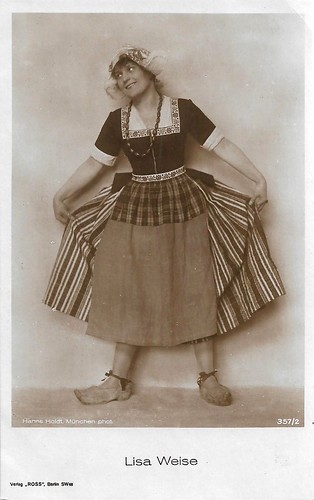
German postcard by Verlag Ross, no. 357/2. Photo: Hanna Holdt, München. Perhaps this card refers to the film Klein Doortje/Little Dorit (Friedrich Zelnik, 1917), starring Lisa Weise, which takes place in the Netherlands.

German postcard by Photochemie, Berlin, no. K. 2276. Photo: Berliner Film-Manufaktur. Friedrich Zelnik and Lupu Pick in Die Rothenburger/The Rothenburgers (Lupu Pick, 1918).
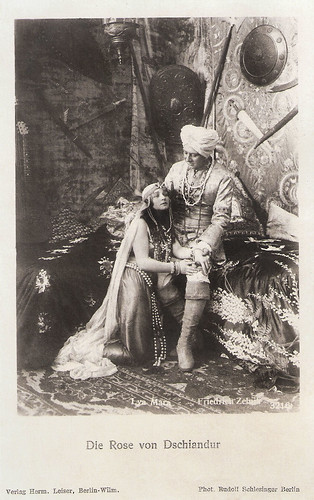
German postcard by Verlag Hermann Leiser, Berlin-Wilm, no. 3216. Photo: Rudolph Schlesinger. Friedrich Zelnik and Lya Mara in Die Rose von Dschiandur/The Rose of Dschiandur (Alfred Halm, 1918).
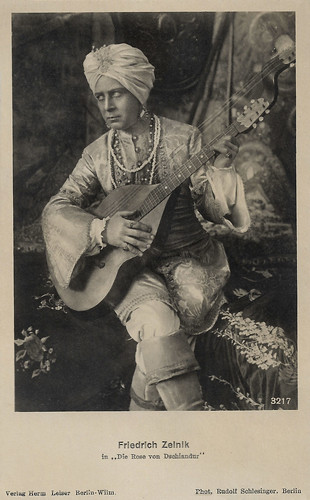
German postcard by Verlag Hermann Leiser, Berlin-Wilm, no. 3217. Photo: Rudolph Schlesinger. Friedrich Zelnik in Die Rose von Dschiandur/The Rose of Dschiandur (Alfred Halm, 1918).
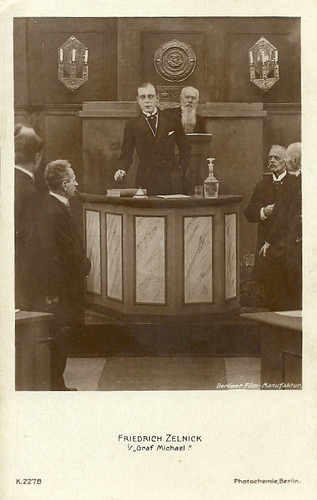
German postcard by Photochemie, Berlin, no. K. 2278. Photo: Berliner Film-Manufaktur. Friedrich Zelnik in Graf Michael/Count Michael (Alfred Halm, 1918). Collection: Didier Hanson.

German postcard by Verlag Hermann Leiser, Berlin-Wilm., no. 5448. Photo: Berliner Film-Manufaktur. Lisa Weise in Das grosse Los/The big prize (Friedrich Zelnik, 1917).
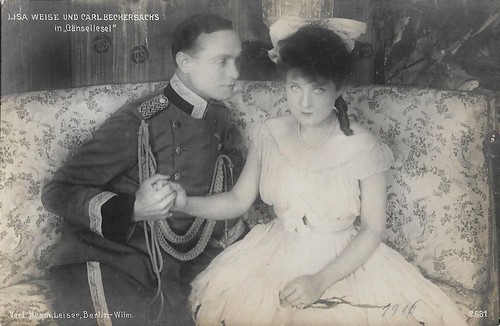
German postcard by Verlag Hermann Leiser, no 2681. Photo: Berliner Film-Manufaktur. Lisa Weise and Karl Beckersachs in Gänseliesel (Friedrich Zelnik, 1918).
In 1918, Friedrich Zelnik met in Warsaw a young Polish ballet dancer turned film actress named Lya Mara. They married and he started to produce and direct films for her. He made Mara a huge star of the German cinema.
Between 1917 and 1922, the Berliner Film-Manukfaktur produced more than 120 films. From 1920 on, Zelnik's companies ran under several names: Zelnik-Mara-Film GmbH, Friedrich Zelnik-film GmbH, and Efzet-Film GmbH. Zelnik-Mara-Film GmbH produced silent entertainment films in which Mara was the female star.
Together they made very popular, operetta style costume films like An der schönen blauen Donau/The Beautiful Blue Danube (Friedrich Zelnik, 1926) with Harry Liedtke, Die Försterchristl/The Bohemian Dancer (Friedrich Zelnik, 1926) again with Liedtke, Das Tanzende Wien/Dancing Vienna (Friedrich Zelnik, 1927), and Heut' tanzt Mariett/Marietta (Friedrich Zelnik, 1928) with Fred Louis Lerch.
These films brought Lya Mara and Zelnik enormous success in Germany and beyond. Filmportal.de: ”Zelnik's sentimental costume dramas (…) always ranked among the greatest box office hits of their respective season. Nevertheless, his film version of Gerhart Hauptmann's Die Weber/The Weaver (Friedrich Zelnik, 1927) became popular even with ‘progressive’ critics. To this day, this rather untypical film for Zelnik still mainly accounts for his reputation as a filmmaker.”
Several of his collaborators, including cameraman Frederik Fuglsang and production designer André Andrejew, are perceived today as notable artists of the German silent cinema. Another important collaborator was scriptwriter Fanny Carlsen.
Busy with directing and producing these films, Zelnik did not find the time to appear himself in films anymore. His last film appearance was in Das Geheimnis der alten Mamsell/The Story of the Old Mademoiselle (Paul Merzbach, 1925) starring Marcella Albani.
In 1925, Zelnik was head of the production at Deutsche Fox for six films, and in 1926 he became a board member and the art director of Defu (Deutsche Film Union AG) and Defina (Deutsche First National Pictures GmbH).

German postcard by Ross Verlag, no. 914/1, 1925-1926. Photo: Phoebus Film / Zelnik-Mara Film. Lya Mara in Auf Befehl der Pompadour/By Order of Pompadour (Friedrich Zelnik, 1924).
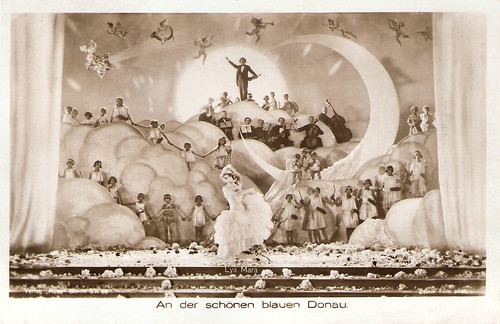
German postcard by Ross Verlag, no. 56/3, 1925-1926. Photo: Zelnik Film. Publicity still for An der schönen blauen Donau/The Beautiful Blue Danube (Friedrich Zelnik, 1926) with Lya Mara. Collection: Geoffrey Donaldson Institute.

German postcard by Ross Verlag, Berlin, no. 77/3. Photo: Zelnik-Film. Hermann Picha, Wilhelm Dieterle and Hertha von Walther in Die Weber (Friedrich Zelnik, 1927).
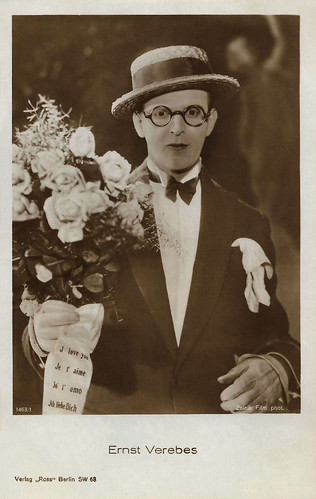
German postcard by Ross Verlag, no. 1463/1, 1927-1928. Photo: Zelnik Film. Ernst (or Ernö) Verebes in Der Veilchenfresser/The violet eater (Friedrich Zelnik, 1926).

German postcard by Ross Verlag, no. 82/3. Photo: Defu. Lya Mara and Ben Lyon in Das tanzende Wien/Dancing Vienna (Friedrich Zelnik, 1927).

German postcard by Ross Verlag, no. 3414/1, 1928-1929. Photo: Defina / DEFU. Fred Louis Lerch and Lya Mara in Heut tanzt Mariett/Today dances Mariett (Friedrich Zelnik, 1928). Collection: Geoffrey Donaldson Institute.

French postcard by Europe, no. 321. Photo: Mercur Film. Fred Louis Lerch and Lya Mara in Mary Lou (Friedrich Zelnik, 1928).

German postcard by Ross Verlag, no. 3856/1, 1928-1929. Photo: Efzet-Film. Fred Louis Lerch in Mary Lou (Friedrich Zelnik, 1928).
Upon the introduction of sound film, Friedrich Zelnik became the first director in Europe to post synchronise a film, the Edgar Wallace adaptation Der rote Kreis/The Crimson Circle (Friedrich Zelnik, 1929) starring Lya Mara and Stewart Rome. In London, he used the DeForest Phonofilm sound-on-film process and added music by Edmund Meisel.
In 1930, the Friedrich Zelnik-Film GmbH went into liquidation and Zelnik travelled to Hollywood, California. Upon his return, he directed his first full sound film, a new version of his silent success Die Försterchristl/The Bohemian Girl (Friedrich Zelnik, 1931) featuring Irene Eisinger.
He had no problems adapting his operetta style to the sound film, and soon more musicals like Walzerparadies/Waltz Paradise (Friedrich Zelnik, 1931) with Charlotte Susa, Jeder fragt nach Erika/Everyone asks for Erika (Friedrich Zelnik, 1931) with Lya Mara in her only sound film role, and Spione im Savoy-Hotel/The Gala Performance (Friedrich Zelnik, 1932) with Alfred Abel.
After Adolph Hitler took power in 1933, Zelnik and Lya Mara left Germany for London. His first British film was the musical comedy Happy (Friedrich Zelnik, 1933) with Stanley Lupino. It was an English remake of Es war einmal ein Musikus/There was once a musician (Friedrich Zelnik, 1933), the last film he had made in Germany.
In the years to follow Zelnik, now Frederic (or Fred) Zelnik, continued to direct and produce films in Great Britain and The Netherlands. Among his British films are the musicals Southern Roses ( Frederic Zelnik, 1934), The Lilac Domino (Frederic Zelnik, 1937) with S.Z. Szakall in a supporting part, and I Killed the Count (Frederic Zelnik, 1939) starring Ben Lyon.
In the Netherlands, he directed Vadertje Langbeen/Daddy Long Legs (Friedrich Zelnik, 1938) based on the popular and often filmed novel by Jean Webster, and Morgen gaat ’t beter!/Tomorrow It Will Be Better (Friedrich Zelnik, 1939). Both films were produced by German émigré producer and distributor Rudolf Meyer, and starred Dutch actress Lily Bouwmeester.
Zelnik took British citizenship. After 1940 he only worked as a producer, in cooperation with British National. His later work included the musical Give Me the Stars (Maclean Rogers, 1945) and the British-Italian drama The Glass Mountain (Henry Cass, 1949) with Michael Denison and Valentina Cortese.
Together with Raymond Stross, he founded Zelstro Films to produce the film Hell Is Sold Out (Michael Anderson, 1951) but Zelnik did not live to see its completion. Friedrich Zelnik died in 1950 in London. He was 65.
His wife, Lya Mara, passed away in November 1969 in Lausanne, Switzerland.
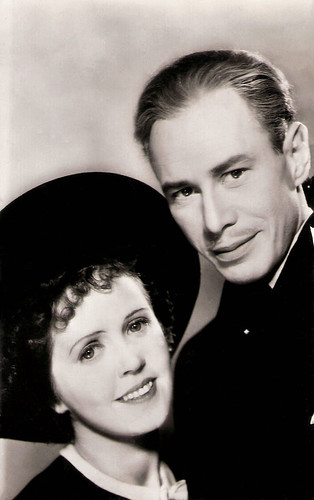
Dutch promotion card by Cinema Odeon, Den Haag. Photo: Neerlandia. Publicity still for Vadertje Langbeen/Daddy Longlegs (Friedrich Zelnik, 1938) with Lily Bouwmeester as Judy and Paul Storm as Vadertje Langbeen.
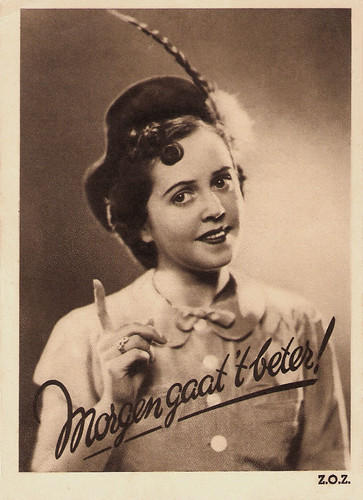
Dutch postcard by Colosseum Theater, Rotterdam. Photo: Neerlandia-Filmex. Publicity still for Morgen gaat het beter/Tomorrow It Will Be Better (Friedrich Zelnik, 1939) with Lily Bouwmeester.
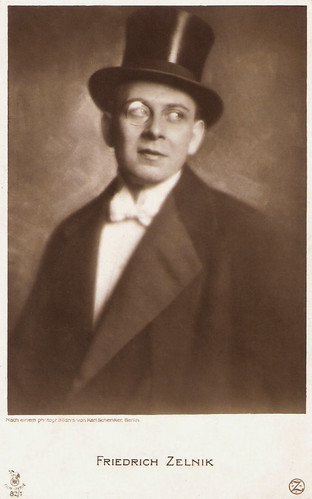
German postcard by Rotophot in the Film Sterne Series, Berlin, no. 82/1. Photo: Karl Schenker, Berlin.

German postcard by Rotophot in the Film Sterne Series, Berlin, no. 82/3. Photo: Karl Schenker, Berlin. Collection: Didier Hanson.
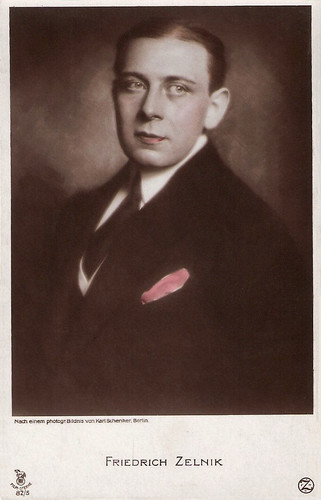
German postcard by Rotophot in the Film Sterne series, no. 82/5. Photo: Karl Schenker, Berlin.
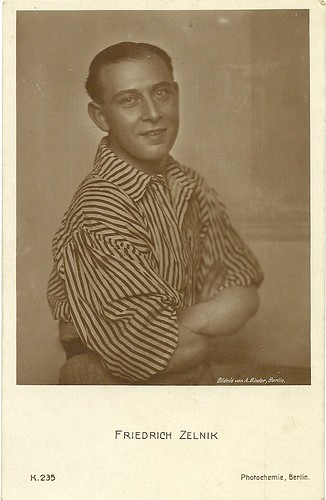
German postcard by Photochemie, Berlin, no. K. 235. Photo: Alex Binder, Berlin. Collection: Didier Hanson.
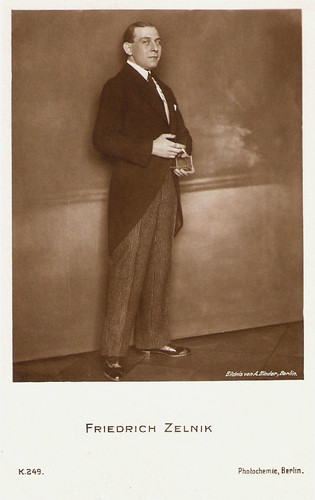
German postcard by Photochemie, Berlin, no. K. 249. Photo: Alex Binder, Berlin.
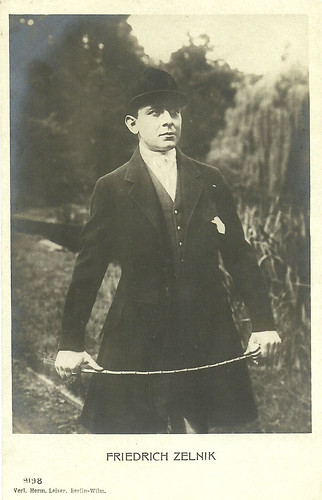
German postcard by Verlag Hermann Leiser, Berlin-Wilm., no. 3198 (?). Collection: Didier Hanson.

German postcard by Ross Verlag, no. 341/2, 1919-1924. Photo: Becker & Maass Phot.
 German postcard by Ross Verlag, no. 1089/1, 1927-1928. Photo: Atelier Bieber, Berlin.
German postcard by Ross Verlag, no. 1089/1, 1927-1928. Photo: Atelier Bieber, Berlin.
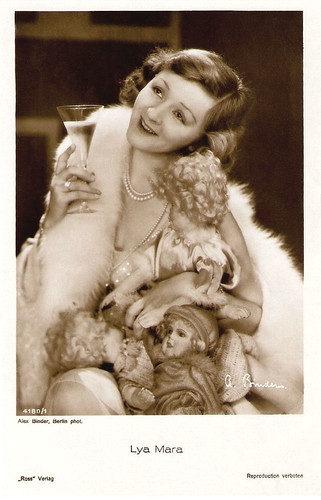
Lya Mara. German postcard by Ross Verlag, no. 4180/1, 1929-1930. Photo: Alex Binder, Berlin.
Sources: Filmportal.de, Stephanie d'Heil (Steffi-Line.de), Wikipedia (English and Dutch), and IMDb.

German postcard by Photochemie, no. K. 234. Photo: Alex Binder, Berlin.

German postcard by Ross Verlag, Berlin, no. 77/2 Photo: Zelnik-Film. Wilhelm Dieterle and Hermann Picha in Die Weber/The Weavers (Friedrich Zelnik, 1927).

German postcard by Rotophot in the Film Sterne series, no. 82/5. Photo: Karl Schenker, Berlin.

German postcard by Rotophot in the Film Sterne series, no. 126/3. Photo: Nicola Perscheid, Berlin.

German postcard by Ross Verlag, no. 3413/1. Photo: Defina / Defu. Lya Mara in Heut tanzt Mariett/Marietta (Friedrich Zelnik, 1928).
Messter
Friedrich Zelnik was born in 1885 in a Jewish family in Czernowitz, then the capital of the Duchy of Bukovina in the Austrian part of the Austro-Hungarian Monarchy (today Chernivtsi, Ukraine). Czernowitz was largely populated by Jews. After Wilno it was the most important city for the Jewish culture in Eastern Europe.
Zelnik studied law in Vienna, but then worked as an actor in theatres in Nürnberg, Aachen, Worms, Prague and finally Berlin, where he appeared in Theater an der Königsgrätzer Straße, Berliner Theater and Komödienhaus.
In 1910 he began to act in short silent films for Messters Projektion GmbH, such as Verkannt/Misunderstood (N.N., 1910), Japanisches Opfer/Japanese victims (Adolf Gärtner, 1910) with Max Mack, and Im Glück vergessen/Forget the luck (Adolf Gärtner, 1911) with silent superstar Henny Porten.
For another company, he played the lead in Europäisches Sklavenleben/European slave life (Emil Justitz, 1912). These films made him one of the first German film stars.
Then there was an interval in his film career of three years during which Zelnik set up his own production company, Berliner Film-Manukfaktur, together with Walter Behrend and Max Liebenau.
In 1915, he started to produce and direct films while he still also played parts in other directors’ films. Among these films were the Sherlock Holmes mystery Das dunkle Schloß/The Hound of the Baskervilles: The Dark Castle (Willy Zeyn, 1915) starring Eugen Burg as Holmes, Arme Maria/Poor Mary (Willy Zeyn, Max Mack, 1915) featuring Hanni Weisse, and Die Fiebersonate/The Fever Sonata (Emmerich Hanus, 1916) with Lotte Neumann.
This latter film he also produced. Other early productions were Ein Zirkusmädel/A Circus Girl (Carl Wilhelm, 1917) with Lisa Weise, and the Charles Dickens adaptation Klein Doortje/Little Dorrit (Friedrich Zelnik, 1917).

German postcard by Verlag Ross, no. 357/2. Photo: Hanna Holdt, München. Perhaps this card refers to the film Klein Doortje/Little Dorit (Friedrich Zelnik, 1917), starring Lisa Weise, which takes place in the Netherlands.

German postcard by Photochemie, Berlin, no. K. 2276. Photo: Berliner Film-Manufaktur. Friedrich Zelnik and Lupu Pick in Die Rothenburger/The Rothenburgers (Lupu Pick, 1918).

German postcard by Verlag Hermann Leiser, Berlin-Wilm, no. 3216. Photo: Rudolph Schlesinger. Friedrich Zelnik and Lya Mara in Die Rose von Dschiandur/The Rose of Dschiandur (Alfred Halm, 1918).

German postcard by Verlag Hermann Leiser, Berlin-Wilm, no. 3217. Photo: Rudolph Schlesinger. Friedrich Zelnik in Die Rose von Dschiandur/The Rose of Dschiandur (Alfred Halm, 1918).

German postcard by Photochemie, Berlin, no. K. 2278. Photo: Berliner Film-Manufaktur. Friedrich Zelnik in Graf Michael/Count Michael (Alfred Halm, 1918). Collection: Didier Hanson.

German postcard by Verlag Hermann Leiser, Berlin-Wilm., no. 5448. Photo: Berliner Film-Manufaktur. Lisa Weise in Das grosse Los/The big prize (Friedrich Zelnik, 1917).

German postcard by Verlag Hermann Leiser, no 2681. Photo: Berliner Film-Manufaktur. Lisa Weise and Karl Beckersachs in Gänseliesel (Friedrich Zelnik, 1918).
Among the Greatest Box Office Hits
In 1918, Friedrich Zelnik met in Warsaw a young Polish ballet dancer turned film actress named Lya Mara. They married and he started to produce and direct films for her. He made Mara a huge star of the German cinema.
Between 1917 and 1922, the Berliner Film-Manukfaktur produced more than 120 films. From 1920 on, Zelnik's companies ran under several names: Zelnik-Mara-Film GmbH, Friedrich Zelnik-film GmbH, and Efzet-Film GmbH. Zelnik-Mara-Film GmbH produced silent entertainment films in which Mara was the female star.
Together they made very popular, operetta style costume films like An der schönen blauen Donau/The Beautiful Blue Danube (Friedrich Zelnik, 1926) with Harry Liedtke, Die Försterchristl/The Bohemian Dancer (Friedrich Zelnik, 1926) again with Liedtke, Das Tanzende Wien/Dancing Vienna (Friedrich Zelnik, 1927), and Heut' tanzt Mariett/Marietta (Friedrich Zelnik, 1928) with Fred Louis Lerch.
These films brought Lya Mara and Zelnik enormous success in Germany and beyond. Filmportal.de: ”Zelnik's sentimental costume dramas (…) always ranked among the greatest box office hits of their respective season. Nevertheless, his film version of Gerhart Hauptmann's Die Weber/The Weaver (Friedrich Zelnik, 1927) became popular even with ‘progressive’ critics. To this day, this rather untypical film for Zelnik still mainly accounts for his reputation as a filmmaker.”
Several of his collaborators, including cameraman Frederik Fuglsang and production designer André Andrejew, are perceived today as notable artists of the German silent cinema. Another important collaborator was scriptwriter Fanny Carlsen.
Busy with directing and producing these films, Zelnik did not find the time to appear himself in films anymore. His last film appearance was in Das Geheimnis der alten Mamsell/The Story of the Old Mademoiselle (Paul Merzbach, 1925) starring Marcella Albani.
In 1925, Zelnik was head of the production at Deutsche Fox for six films, and in 1926 he became a board member and the art director of Defu (Deutsche Film Union AG) and Defina (Deutsche First National Pictures GmbH).

German postcard by Ross Verlag, no. 914/1, 1925-1926. Photo: Phoebus Film / Zelnik-Mara Film. Lya Mara in Auf Befehl der Pompadour/By Order of Pompadour (Friedrich Zelnik, 1924).

German postcard by Ross Verlag, no. 56/3, 1925-1926. Photo: Zelnik Film. Publicity still for An der schönen blauen Donau/The Beautiful Blue Danube (Friedrich Zelnik, 1926) with Lya Mara. Collection: Geoffrey Donaldson Institute.

German postcard by Ross Verlag, Berlin, no. 77/3. Photo: Zelnik-Film. Hermann Picha, Wilhelm Dieterle and Hertha von Walther in Die Weber (Friedrich Zelnik, 1927).

German postcard by Ross Verlag, no. 1463/1, 1927-1928. Photo: Zelnik Film. Ernst (or Ernö) Verebes in Der Veilchenfresser/The violet eater (Friedrich Zelnik, 1926).

German postcard by Ross Verlag, no. 82/3. Photo: Defu. Lya Mara and Ben Lyon in Das tanzende Wien/Dancing Vienna (Friedrich Zelnik, 1927).

German postcard by Ross Verlag, no. 3414/1, 1928-1929. Photo: Defina / DEFU. Fred Louis Lerch and Lya Mara in Heut tanzt Mariett/Today dances Mariett (Friedrich Zelnik, 1928). Collection: Geoffrey Donaldson Institute.

French postcard by Europe, no. 321. Photo: Mercur Film. Fred Louis Lerch and Lya Mara in Mary Lou (Friedrich Zelnik, 1928).

German postcard by Ross Verlag, no. 3856/1, 1928-1929. Photo: Efzet-Film. Fred Louis Lerch in Mary Lou (Friedrich Zelnik, 1928).
Hollywood
Upon the introduction of sound film, Friedrich Zelnik became the first director in Europe to post synchronise a film, the Edgar Wallace adaptation Der rote Kreis/The Crimson Circle (Friedrich Zelnik, 1929) starring Lya Mara and Stewart Rome. In London, he used the DeForest Phonofilm sound-on-film process and added music by Edmund Meisel.
In 1930, the Friedrich Zelnik-Film GmbH went into liquidation and Zelnik travelled to Hollywood, California. Upon his return, he directed his first full sound film, a new version of his silent success Die Försterchristl/The Bohemian Girl (Friedrich Zelnik, 1931) featuring Irene Eisinger.
He had no problems adapting his operetta style to the sound film, and soon more musicals like Walzerparadies/Waltz Paradise (Friedrich Zelnik, 1931) with Charlotte Susa, Jeder fragt nach Erika/Everyone asks for Erika (Friedrich Zelnik, 1931) with Lya Mara in her only sound film role, and Spione im Savoy-Hotel/The Gala Performance (Friedrich Zelnik, 1932) with Alfred Abel.
After Adolph Hitler took power in 1933, Zelnik and Lya Mara left Germany for London. His first British film was the musical comedy Happy (Friedrich Zelnik, 1933) with Stanley Lupino. It was an English remake of Es war einmal ein Musikus/There was once a musician (Friedrich Zelnik, 1933), the last film he had made in Germany.
In the years to follow Zelnik, now Frederic (or Fred) Zelnik, continued to direct and produce films in Great Britain and The Netherlands. Among his British films are the musicals Southern Roses ( Frederic Zelnik, 1934), The Lilac Domino (Frederic Zelnik, 1937) with S.Z. Szakall in a supporting part, and I Killed the Count (Frederic Zelnik, 1939) starring Ben Lyon.
In the Netherlands, he directed Vadertje Langbeen/Daddy Long Legs (Friedrich Zelnik, 1938) based on the popular and often filmed novel by Jean Webster, and Morgen gaat ’t beter!/Tomorrow It Will Be Better (Friedrich Zelnik, 1939). Both films were produced by German émigré producer and distributor Rudolf Meyer, and starred Dutch actress Lily Bouwmeester.
Zelnik took British citizenship. After 1940 he only worked as a producer, in cooperation with British National. His later work included the musical Give Me the Stars (Maclean Rogers, 1945) and the British-Italian drama The Glass Mountain (Henry Cass, 1949) with Michael Denison and Valentina Cortese.
Together with Raymond Stross, he founded Zelstro Films to produce the film Hell Is Sold Out (Michael Anderson, 1951) but Zelnik did not live to see its completion. Friedrich Zelnik died in 1950 in London. He was 65.
His wife, Lya Mara, passed away in November 1969 in Lausanne, Switzerland.

Dutch promotion card by Cinema Odeon, Den Haag. Photo: Neerlandia. Publicity still for Vadertje Langbeen/Daddy Longlegs (Friedrich Zelnik, 1938) with Lily Bouwmeester as Judy and Paul Storm as Vadertje Langbeen.

Dutch postcard by Colosseum Theater, Rotterdam. Photo: Neerlandia-Filmex. Publicity still for Morgen gaat het beter/Tomorrow It Will Be Better (Friedrich Zelnik, 1939) with Lily Bouwmeester.

German postcard by Rotophot in the Film Sterne Series, Berlin, no. 82/1. Photo: Karl Schenker, Berlin.

German postcard by Rotophot in the Film Sterne Series, Berlin, no. 82/3. Photo: Karl Schenker, Berlin. Collection: Didier Hanson.

German postcard by Rotophot in the Film Sterne series, no. 82/5. Photo: Karl Schenker, Berlin.

German postcard by Photochemie, Berlin, no. K. 235. Photo: Alex Binder, Berlin. Collection: Didier Hanson.

German postcard by Photochemie, Berlin, no. K. 249. Photo: Alex Binder, Berlin.

German postcard by Verlag Hermann Leiser, Berlin-Wilm., no. 3198 (?). Collection: Didier Hanson.

German postcard by Ross Verlag, no. 341/2, 1919-1924. Photo: Becker & Maass Phot.
 German postcard by Ross Verlag, no. 1089/1, 1927-1928. Photo: Atelier Bieber, Berlin.
German postcard by Ross Verlag, no. 1089/1, 1927-1928. Photo: Atelier Bieber, Berlin.
Lya Mara. German postcard by Ross Verlag, no. 4180/1, 1929-1930. Photo: Alex Binder, Berlin.
Sources: Filmportal.de, Stephanie d'Heil (Steffi-Line.de), Wikipedia (English and Dutch), and IMDb.
No comments:
Post a Comment